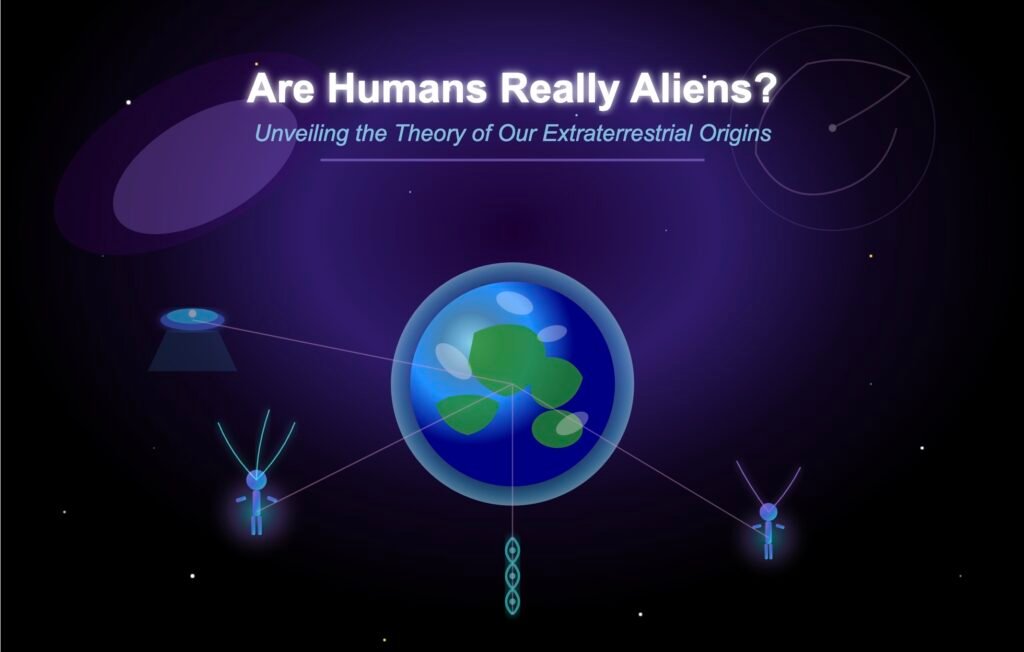Are We Extraterrestrial?
A comprehensive analysis of theories proposing that humanity originated beyond Earth, examining scientific evidence, historical perspectives, and recent developments in our understanding of life’s cosmic origins.
Introduction
The question of human origins has captivated scientists, philosophers, and the general public for centuries. While mainstream science supports the theory of evolution and natural selection explaining human development on Earth, alternative theories suggest our species may have extraterrestrial origins. These hypotheses range from scientifically grounded concepts like panspermia to more speculative ideas involving ancient astronauts.
This comprehensive report examines the various theories proposing that humans are, in essence, aliens on Earth. We’ll explore the scientific foundations, historical development, and current evidence surrounding these fascinating possibilities, while maintaining a critical and objective perspective on each theory’s validity.
Historical Background
Ancient Origins
Greek philosopher Anaxagoras first proposed that life could be distributed throughout the universe, laying the foundation for panspermia theory.
Modern Panspermia
Swedish scientist Svante Arrhenius formally introduced the modern panspermia hypothesis, suggesting life spreads through space via radiation pressure.
Ancient Astronaut Theory
Erich von Däniken published “Chariots of the Gods?”, popularizing the idea that ancient extraterrestrials visited Earth and influenced human development.
Directed Panspermia
Nobel Prize winner Francis Crick and Leslie Orgel proposed that life was deliberately seeded on Earth by intelligent extraterrestrial beings.
Recent Developments
James Webb Space Telescope discoveries of potential biosignatures on exoplanets, including dimethyl sulfide on K2-18b, reignite discussions about extraterrestrial life.
Key Theories
Panspermia Theory
Definition: Panspermia (from Ancient Greek meaning ‘all seed’) hypothesizes that life exists throughout the universe and can be distributed between planets via space dust, meteoroids, asteroids, comets, and planetoids.
Types of Panspermia:
- Radiopanspermia: Microscopic life forms propelled through space by stellar radiation pressure
- Lithopanspermia: Transfer of organisms in rocks between planets via impacts
- Pseudo-panspermia: Distribution of organic compounds rather than living organisms
Scientific Status: Some aspects have scientific support, particularly the discovery of organic molecules in meteorites and comets. However, challenges include radiation damage and atmospheric entry survival.
Directed Panspermia
Proposed by: Francis Crick (Nobel Prize winner, co-discoverer of DNA structure) and Leslie Orgel in 1972.
Core Concept: Life was deliberately brought to Earth by intelligent extraterrestrial beings. This theory suggests that advanced civilizations intentionally seeded planets with microorganisms to initiate life.
Evidence Proposed: The universality of the genetic code across all life forms could suggest a common, designed origin rather than independent evolution.
Scientific Assessment: While intellectually intriguing, this theory lacks empirical evidence and is considered highly speculative by mainstream science.
Ancient Astronaut Theory
Main Proponents: Erich von Däniken, Zecharia Sitchin, Giorgio Tsoukalos
Central Claims:
- Ancient gods were actually extraterrestrial visitors
- Aliens helped build monuments like pyramids and Stonehenge
- Extraterrestrials genetically modified early humans
- Ancient texts contain descriptions of advanced technology
Sitchin’s Anunnaki Theory: Claims that beings from planet “Nibiru” came to Earth 400,000 years ago and genetically engineered modern humans as laborers for gold mining.
Scientific Consensus: Rejected as pseudoscience by mainstream academia due to lack of credible evidence and methodological issues.
🔬 Subscribe to SciMail
Get the latest science discoveries straight to your inbox!
Scientific Evidence
Supporting Evidence
- Organic molecules found in meteorites and comets
- Extremophile organisms surviving space-like conditions
- Rosetta mission detecting complex organics in comets
- Recent exoplanet discoveries with potential biosignatures
- Mathematical models showing lithopanspermia feasibility
Counterarguments
- Space radiation destroys unprotected DNA/RNA
- Atmospheric entry generates lethal temperatures
- No confirmed alien artifacts or genetic signatures
- Natural evolution adequately explains human origins
- Lack of direct evidence for ancient extraterrestrial contact
Scientific Support Levels for Different Theories
Recent Developments (2024-2025)
James Webb Space Telescope Discoveries
The most significant recent development in the search for extraterrestrial life comes from the James Webb Space Telescope’s observations of exoplanet K2-18b:
- Carbon-bearing molecules detected: Methane and carbon dioxide in the planet’s atmosphere
- Potential biosignature: Apparent detection of dimethyl sulfide (DMS), which on Earth is only produced by living organisms
- Hycean classification: K2-18b classified as a potential “Hycean exoplanet” with hydrogen-rich atmosphere and water ocean surface
Implications for Human Origins Theories
While these discoveries don’t directly support theories of human extraterrestrial origins, they do demonstrate:
- The potential abundance of life-supporting conditions in the universe
- The possibility of complex organic chemistry on distant worlds
- The need to expand our understanding of what constitutes a “biosignature”
Comparative Analysis
| Theory | Scientific Basis | Evidence Level | Mainstream Acceptance | Testability |
|---|---|---|---|---|
| Natural Panspermia | Physics, Chemistry, Biology | Moderate | Cautious Interest | High |
| Directed Panspermia | Biochemistry, Genetics | Low | Skeptical | Moderate |
| Ancient Astronaut Theory | Pseudoarchaeology | Very Low | Rejected | Low |
| Natural Evolution | Biology, Genetics, Paleontology | Very High | Consensus | Very High |
Arguments For and Against
Arguments Supporting Extraterrestrial Origins
- Complexity Problem: The rapid emergence of complex life on early Earth suggests external input
- Universal Genetic Code: Could indicate common designed origin
- Organic Molecules in Space: Building blocks of life are widespread in the cosmos
- Extremophile Survival: Some organisms can survive space conditions
- Missing Evolutionary Links: Gaps in fossil record might suggest intervention
- Ancient Anomalies: Unexplained ancient technologies and knowledge
Arguments Against Extraterrestrial Origins
- Evolutionary Evidence: Clear evolutionary lineage from simple to complex life
- Radiation Problem: Space radiation would destroy unprotected organisms
- No Direct Evidence: Absence of confirmed alien artifacts or genetic markers
- Natural Explanations: Abiogenesis and evolution explain life’s origins
- Occam’s Razor: Simpler explanations are preferred without extraordinary evidence
- Archaeological Debunking: Alternative explanations for ancient “anomalies”
Current Scientific Consensus
Mainstream Scientific Position
The current scientific consensus on theories of human extraterrestrial origins can be summarized as follows:
Panspermia (Natural)
Status: Legitimate scientific hypothesis with ongoing research
Support: Some evidence for organic molecules and extremophile survival
Challenges: Radiation damage and atmospheric entry problems
Directed Panspermia
Status: Highly speculative, lacks empirical support
Support: Proposed by respected scientists, addresses complexity issues
Challenges: No testable predictions, lacks evidence
Ancient Astronaut Theory
Status: Rejected as pseudoscience
Support: Popular culture appeal, explains some ancient mysteries
Challenges: No credible evidence, methodological flaws, racism concerns
Research Directions
Current scientific efforts focus on:
- Laboratory experiments on organism survival in space conditions
- Mathematical modeling of panspermia between planetary systems
- Analysis of exoplanet atmospheres for biosignatures
- Continued study of organic molecules in meteorites and comets
- Search for current extraterrestrial life rather than ancient visitation evidence
Conclusion
The question of whether humans have extraterrestrial origins remains one of the most fascinating and controversial topics in science. While various theories have been proposed—from natural panspermia to directed seeding by intelligent aliens—none have garnered conclusive scientific support.
Key Findings:
- Natural panspermia has some scientific merit and continues to be studied, though significant challenges remain
- Directed panspermia, while proposed by respected scientists, lacks empirical evidence and remains highly speculative
- Ancient astronaut theories are rejected by mainstream science as pseudoscientific
- Recent discoveries of potential biosignatures on exoplanets add excitement to the search for extraterrestrial life but don’t support human alien origins
The scientific consensus maintains that human evolution on Earth through natural processes remains the most supported explanation for our origins. However, the discovery of organic molecules in space and the potential for life on other worlds keeps the door open for continued research into life’s cosmic connections.
Future Prospects: As we advance our understanding of astrobiology, exoplanet research, and the limits of life, we may gain new insights into the possibility of life’s interplanetary transfer. Until then, the question of our potential extraterrestrial origins remains an intriguing scientific frontier that continues to inspire research, debate, and wonder about our place in the cosmic community.


Leave a Reply